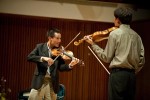Title
In June, the sixth biennial Starling-DeLay Symposium on Violin Studies was held, with some 200 teachers and students from 32 states and 14 countries participating. The five-day event included six master classes, among them one taught by the newest member of the violin faculty, Joseph Lin, who also performed with his colleagues in the Juilliard String Quartet at the symposium. He describes his experiences here. Other master classes were taught by Itzhak Perlman, Glenn Dicterow, Ida Kavafian, and David Updegraff.
Faculty member Joseph Lin (left) works with student artist Brandon Garbot at the Starling-DeLay Symposium. “We can all credit countless hours of practice for getting us to where we are,” Lin writes. But “our goal as musicians is to engage in a deeply expressive act, drawing on a creative impulse that is always evolving.”
(Photo by Nan Melville)Body
The Starling-DeLay Symposium on Violin Studies gives teachers and students from diverse backgrounds an opportunity to focus on the art of teaching and learning. Having had the good fortune of taking part in two events at the symposium, I too found myself thinking about pedagogy and reflecting on what I have learned, both from my many wonderful teachers and from my own experiences as a teacher. My involvement in the symposium began with a master class for five violinists. The repertoire played included several movements of unaccompanied Bach, as well as a Prokofiev concerto and a Brahms sonata. The next day, my participation came in the form of a Juilliard String Quartet performance of Beethoven’s Quartet in B-flat Major, Op. 130, with the Grosse Fuge, followed by an open discussion with the audience.
During the master class, I was very impressed not only with the quality of playing among the violinists, who ranged from high school age to master’s degree candidates, but also with the responsiveness of each student. Not long ago I was in their shoes, no doubt intimidated by the setting: playing for a new teacher is hard enough, never mind having 200 other violinists looking on! (Perhaps it was with the Juilliard Pre-College violinist that I could most closely identify, for my last official status at Juilliard before joining the faculty had been as a Pre-College kid.) In my role as a teacher, I hoped that I had something worthwhile to share, that the lessons and ideas I had gained since my Pre-College days would be meaningful for each student’s development as a creative and expressive individual.
I enjoyed probing deeply into the unaccompanied works of Bach: in these pieces, the many choices violinists must make—of voicing, tempo, articulation, dynamic, chord execution, etc.—can often seem overwhelming. Yet keen ears, patience, and an open mind while practicing can gradually make playing Bach a liberating experience.
For me, this process of exploration and experimentation makes teaching exciting, for I find myself learning along with the students. In the Prokofiev concerto, for example, Marié Rossano played a passage in a way that was quite new to me; her interpretation entered my memory bank, to be drawn upon the next time I work on the piece. Hearing Francisco Garcia-Fullana’s rendition of a Brahms sonata, instinct led me to suggest greater emphasis on a particular motivic idea; but it was only in trying to articulate my reasoning that I discovered compositional clues of which I had been only semi-conscious until then.
Likewise, there were many discoveries to be made in the process of preparing and rehearsing the Beethoven Opus 130 and Grosse Fuge for the Juilliard String Quartet’s performance the following day. My colleagues in the quartet had of course played the piece countless times before, and I had studied and performed it with the alternate finale a few years ago. Yet for all of us, coming back to this great work was at least as exciting and vital as when we first encountered it. To be sure, our past experiences were not discarded; but more important was our unceasing search for new ways to understand and convey the profound intellectual and emotional meaning of Beethoven’s music.
What I was most eager to share with the symposium participants was something I have learned from my teachers and students, as well as from my experiences in the Juilliard String Quartet: making music is a living process. It is more than simply replicating an historical ideal or achieving a perfect execution of the notes in the score. Rather, it is human creativity in a continuous dialogue that connects past and present, reaching out from one culture to another. We can all credit countless hours of practice for getting us to where we are; but let us not forget that our goal as musicians is to engage in a deeply expressive act, drawing on a creative impulse that is always evolving.





